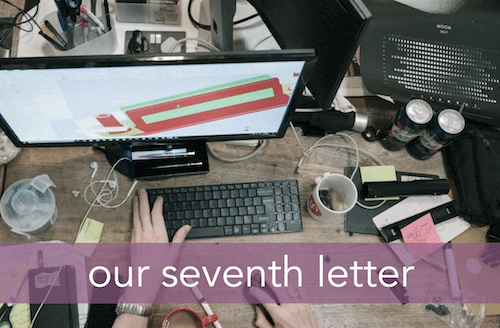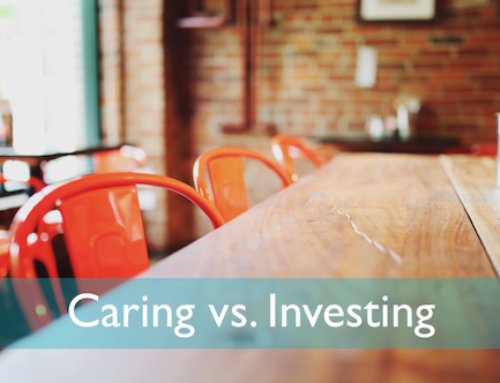Letter seven is about a little secret I learned during my years as a professional organizer. And, more importantly, it’s about my encounter with “naivete tax” (a.k.a. the time I talked myself out of a few hundred much-needed dollars).
Very early on in my organizing career, I realized that 92% of my clients did not have a problem with organizing.
When someone has a problem with understanding and implementing the basic principles of organizing, you walk into their space and everything is everywhere… there’s bathroom stuff in the kitchen and kitchen stuff in the bedroom and bedroom stuff in the living room. Basically, items that are alike are not being stored together.
(I’m NOT talking about hoarding here. Hoarding is the outward manifestation of psychological issues and/or trauma which cannot – as in: never ever ever – be remedied by organizing alone.)
Time and again, I would tour my client’s space and realize that “disorganization” was technically a misdiagnosis.
What, then, was the actual root of the frustration that compelled them to contact me?
After getting a dozen or so clients under my belt, I had asked and answered that question and realized what my job was truly about.
I can distinctly remember the gig where the pieces fell into place around this little secret (and I call it a “secret” merely because I still haven’t heard it addressed very often by other organizational experts).
This particular client was an actor and voice over artist living in a lovely apartment with her partner… living area, dining area, kitchen, bathroom, master bedroom, and a second bedroom that they were sharing as an office.
She wanted me to help her organize the office. Even though it was already fairly organized. (The room was arranged logically and items were stored logically.)
Organized or not, she felt irritated when working in there and wasn’t able to do tasks with any semblance of ease or flow. She was trying to grow her career and she felt her office space was actively working against her.
Her situation fit right into the pattern – the secret – that I was noticing.
You see, once upon a time, she and her partner had arranged this office in a way that suited who they were and what they were up to. Over the years since then, she had changed and grown and now her space no longer reflected nor supported the person she had become.
She had evolved but her space had not.
And, even if they didn’t know it, THAT was the problem the majority of my clients were hiring me to resolve.
I pointed out to this client that, although she was asking her career to expand even further that it already had, she was only giving it a smidge of literal room in which to do so.
Between her computer, recording equipment, and office supplies, there was exactly 8.5×11 inches of available “workspace.” Just enough space for us to lay one sheet of paper flat upon her desk.
So began a three hour conversation about why her earnings and advancement are likely being constricted by the physical confines of her office space because she is expending so much precious energy each time she has to navigate around and reconfigure stuff just to get something accomplished in there… and about how the same thing was probably true for her partner… and about how they liked the idea of throwing formal dinner parties but in reality their dinning area went mostly unused… and about how turning the dining area into her office and letting her partner take over the current office would Be The Thing that would allow them to earn more so they could move into more spacious quarters where they would feel comfortable hosting lots of parties…
…and about how living within an “idealized space” (like maintaining an unused dining area for parties that you aren’t in the phase of life to throw) can be just as detrimental as living in a space that was designed to serve a former version of you.
I remember sitting on her couch and asking her to imagine her apartment completely empty – to imagine that she and her partner were moving into this space for the very first time today. I asked her to think about how they would arrange the rooms to suit the people they currently are and the needs they currently have.
And then, at the end of that little exercise, our session was over. And then she got out her checkbook. And then I told her she didn’t owe me anything.
She was utterly confused. She was satisfied! She was excited! She was totally expecting to pay me!
Wanna know why I refused to take the payment that she offered to me several times?
Because I felt guilty that I hadn’t done any “work.” All we had done was talk. I’d never had an appointment where I hadn’t physically moved anything around – like not one single thing.
All of which I tried to explain to her as she tried to explain to me how much the session had helped her.
Yet I left without taking the money.
And it wasn’t until I had walked all the way back to my car, got in, and buckled up that I finally understood that OH MY GOD, I SHOULD HAVE TAKEN THE MONEY.
Because I had, actually, earned it.
Up until that moment however, I thought I was being paid for my expertise in combination with my labor. This was the first time someone was suggesting that my guidance alone was valuable and, inside my sweetly naive brain, that idea did. not. yet. compute.
Luckily, I had a nice, long car ride home to let all of this sink in… and to come to terms with the fact that I had just “spent” about $300 of my rent money to learn this lesson.
Here’s the thing though – in life, and especially in business – if you learn a lesson the first time it is taught to you, you will likely eventually recoup whatever it cost you to learn it. Dedicating myself (as much as is humanly possible) to avoiding having to repeat any lesson more than once has definitely contributed to my success.
And even though, ruefully, there are always new lessons to be learned, I know from experience how much time, energy, and money can be saved by being a quick and humble student.
Wishing you the very best,





